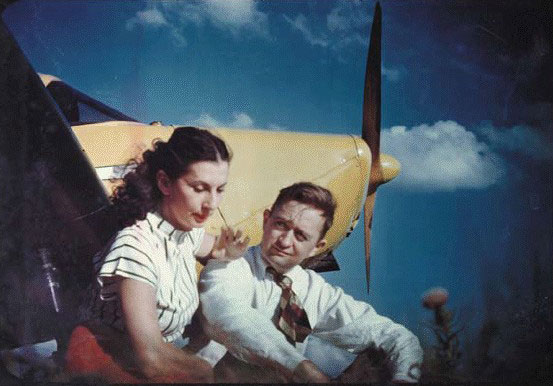- Relief printing
- Intaglio and planographic printing
- Color printing
- Bits and pieces
- Early photography in silver
- Non-silver processes
- Modern photography
- Color notes
- Color photography
- Photography in ink: relief and intaglio printing
- Photography in ink: planographic printing
- Digital processes
- Where do we go from here?
Kodacolor and Kodachrome

Kodachrome print. Photographer unknown. Mariam and James McGlone with their Piper Cub. 1946. 5 1/2 x 7 7/8" (14 x 20 cm). The Museum of Modern Art, New York. Gift of Richard Benson. This print was made directly from a Kodachrome transparency.
In the 1930s the Eastman Kodak Company introduced the first widely available color materials that could be handled by the amateur. The processing and printing still needed to be done in a lab, but Eastman had long since built up a huge business of processing and printing film exposed by the public. The new materials were revolutionary in that individual color separations were no longer needed–each single sheet of film held three sensitive layers, each producing one of the primary color records. Like the old individual separations, these emulsion coatings were black and white, but they were converted to dye images of the proper color during processing. This color revolution started with large film in sheets and movie film for professional use and was followed by 35mm and small format film for sale in the widespread and lucrative amateur market. These films and papers were miracles of construction.
The old black and white films had themselves been complicated enough to require laboratory conditions when they were manufactured—they simply could not be created at home—but the color materials only came about because Kodak, and a small number of other companies, made immense investments to build the factories that could manufacture these terrifically complex materials, and do so in the huge quantities that would make them available at a reasonable cost. The economic reality of single-sheet color materials is that they only come to us because of the advantages of mass production and carefully evolved manufacturing and marketing systems; if we tried to make a single box of 35mm color film on our own, it would cost millions of dollars. We find the same reality in the automotive industry, where the simplest mass-produced car is a miracle of refinement and accumulated experience, only accessible to the common man because of the cooperative economy in which we live. Photography had come a long way from the home-cooking techniques of its origins a hundred years before.

